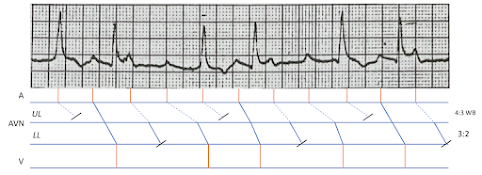Another great case from Dave Richley, @DaveRichley
My hypothesis:
Orange
arrows: Sinus P waves (mostly stable PP CL)
Solid
black line: Fast Pathway (FP). Dashed black line: Slow Pathway (SP)
Fundamentally,
dual AVN conduction. The basic, recurring them (demonstrated in QRS 2 and 3)
Sinus conduction down FP. Then, preferential utilization of SP because FP is
refractory to antegrade travels, however subsequently recovers enough to permit
momentary retrograde conduction into the Atria (blue upright arrow). This would
otherwise reset the PP CL, but the assumption here is that the SN is protected
via entrance block. Thus, it fires, and the surrounding Atrial tissue is
receptive to its impulse, however fails to effectively enter the AVN.
QRS
9 is ventricular extrasystole
that invades the AVN and stifles what should have been SP conduction at this
predictable moment in time. I initially considered the very next PR-interval
(associated with QRS 10) to be the consequence of concealed conduction into FP.
–And this remains a possibility. However, given that the PR-interval here
shares similar distance to all previous SP conduction, I think it might be
preferential use of SP because FP remains refractory from the extrastystolic
penetration.
From Dave Richley:
In his words:
Beat 2: conducts down fast AVN p/way
Beat 3: block in fast p/w. Conducts down slow p/w, then retrograde conduction up fast p/w & thru atria causing pseudo r’ and scooped ST seg.
Retrograde concealed conduction from PVC blocks conduction in both p/ws.














